1. Semasiology and Semantics compared.
Historical
development of Semasiology.
2. Classifications of semantic changes.
I
The
branch of the study of language concerned with the meaning of words
and word equivalents is called semasiology, (semasia- from Greek
“signification”).As semasiology deals only with lexical meaning
of a word it may be regarded as a branch of Lexicology.
It
doesn’t mean that semasiology has nothing to do with grammatical
meaning. It must also be taken into consideration as it bears a
specific influence upon lexical meaning.
Using
diachronic approach, we may say that semasiology studies the change
in meaning that words undergo.
Descriptive
synchronistic approach demands the study not of individual words but
of semantic structures typical of the language studied and of its
general semantic system.
The
main objects of semasiological study we shall speak about are:
Semantic development of words, its causes and classification,
relevant distinctive features and types of lexical meaning, polysemy
and semantic structure of words, semantic grouping and connections in
the vocabulary system, i.e. synonyms, antonyms, terminological
systems, etc.
As
for the two terms “semasiology” and “semantics”, on the one
hand they are synonymous. But in fact they are synonyms but not
equally appropriate for our purpose. The term “semasiology” is
preferable because it is less ambiguous. The only meaning it has is
that given below. The term semantics is used to cover several
different meanings. To avoid confusion the term “semasiology”
will be used.
Semasiology
is one of the youngest branches of linguistics although the objects
of its study have attracted the attention of philosophers and
grammarians since the times of antiquity. We find the problems of
word and notion relationship discussed in the works of Plato and
Aristotle and the famous Indian Grammarian Panini.
Semasiology
came into its own only in the 1830’s when it was suggested by the
representatives of German linguistic school, that the studies of
meaning should be regarded as an independent branch of knowledge.
At
that first stage semasiology had as its source philological studies.
It grew out of commentaries upon the meaning of this or that word
with an old author and comparisons with earlier and present-day
usage.
The
treatment of meaning throughout the 19th
century and in the first decade of the 20th
was purely diachronistic. Attention was concentrated upon the process
of semantic change. Semasiology was even defined at that time as a
linguistic science dealing with the changes in word meaning, their
causes and classification.
Negative
sides: semantic changes were traced and described for isolated
word-units without taking into account the interrelation of
structures existing within each language.
Thus,
it was impossible to formulate any general tendencies peculiar to the
English language.
As
for the English vocabulary, the accent in its semantic study was in
the 19th
century shifted to lexicographical problems. The Golden Age of
English lexicography began in the middle of the 19th
century when the great work, the Oxford Dictionary of the English
language on Historical Principles was carried out.
II
Semantic
changes have been variously classified into such categories as:
enlargement (or extension), narrowing, generalization,
specialization, transfer (metaphor and metonymy), irradiation,
amelioration, pejoration and many others.
These
numerous classifications might be subdivided into logical,
psychological, sociological and genetic. No satisfactory or
universally accepted scheme of classification has ever been found and
this line of search seems to be abandoned.
The
authors of the earliest classifications treated semantic change as a
logical process conditioned psychologically and classed its types
under the headings of the figures of speech: synecdoche, metonymy,
metaphor.
The
synecdoche
covers not only all cases in which a part is put for the whole, or
the whole for a part, but also — the general for the special and the
special for the general, i.e. what was later termed as specialization
or narrowing and generalization or widening.
The
metonymy
applies the name of one thing to another with which it has some
permanent connection. The relations may be those of cause and result,
symbol and thing symbolized, container and content, etc.
The
metaphor
applies the name of one thing to another to which it has some
resemblance.
They
considered the last type of semantic change to be the most important
of the three.
The
classification has its drawback, as it mixes facts of language with
those of the literary style.
Later
on to the classification were added: hyperbole, vulgarism, litotes,
and euphemism (they will be discussed later).
In
the 20th
century the progress of semasiology was uneven. The theory of
semantic field, treating semantic phenomena historically and within a
definite language system at a definite period of its development was
offered.
The
study of semantic change is very important as the development and
change of the semantic structure of a word is always a source of
qualitative and quantitative development of the vocabulary.
When
studying it we are to compare:
We
may compare the earlier and the new meaning of the given word. This
comparison may be based on the difference between notions expressed
or referents in the real world that are pointed out, or on some other
features. This difference is revealed in the difference of contexts,
in which these words occur, in their different valency.
E.g.
the word “play” suggests different notions to a child, a
playwright, a footballer, a musician or a chess-player and has in
their speech different semantic paradigms. A word which formally
represented a notion of a narrower scope has come to render a notion
of a broader scope. When the meaning is specialized, the word can
name fewer objects, i.e. have fewer referents.
The
reduction of scope accounts for the term “narrowing of meaning”
which is even more often used than the term “specialization”.
There
is also a third term for the same phenomenon, namely
“differentiation”, but it is not so widely used as the first two
terms.
The
process reverse to specialization is termed “generalization and
widening of meaning”. In this case the scope of the new notion is
wider than that of the original one, whereas the content of the
notion is poorer. In most cases generalization is combined with a
higher order of abstraction than in the notion expressed by the
earlier meaning. The transition from a concrete meaning to an
abstract one is a most frequent feature in the semantic history of
words.
Соседние файлы в предмете [НЕСОРТИРОВАННОЕ]
- #
- #
- #
- #
- #
20.03.2015540.67 Кб9W3.doc
- #
- #
- #
- #
- #
- #
1
THE SEMANTIC STRUCTURE OF WORDS LECTURE 4
2
1. Semasiology as a branch of Linguistics. 2. The word and its meaning. 3. Types of meaning. 4. Polysemy of English words. 5. The main semantic processes.
3
1. Semasiology as a Branch of Linguistics
4
Semasiology is the branch of the study of language concerned with the meaning of words and word equivalents. As semasiology deals not with every kind of meaning but with the lexical meaning only, it may be regarded as a branch of Lexicology.
5
2. The Word and its Meaning
6
There are two schools of thought in present- day linguistics representing the main lines of contemporary thinking on the problem: the referential approach which seeks to formulate the essence of meaning by establishing the interdependence between words and things or concepts they denote the functional approach, which studies the functions of a word in speech and is less concerned with what meaning is than with how it works
7
All major works on semantic theory have so far been based on referential concepts of meaning.
8
The essential feature of this approach is that it distinguishes between the three components closely connected with meaning: the sound form of the linguistic sign, the concept underlying this sound form and the referent. The best known referential model of meaning is the so-called basic triangle.
9
CONCEPT SOUND FORM REFERENT
10
The sound form of the linguistic sign, e.g. [teibl], is connected with our concept of the piece of furniture which it denotes and through it with the referent, i.e. the actual table. The common feature of any referential approach is the implication that meaning is in some form or other connected with the referent.
11
Meaning and Sound Form
12
The sound form of the word is not identical with its meaning. The connections are conventional and arbitrary. This can be easily proved by comparing the sound forms of different languages conveying the same meaning: стіл- стол- table – tisch.
13
For more convincing evidence of the conventional and arbitrary nature of the connection between sound form and meaning all we have to do is to point to homonyms. The word case means something that has happened and case also means a box, a container.
14
Meaning and Concept
15
Concept is the category of human cognition. Concept is the thought of the object that singles out its essential features. Our concepts reflect the most common and typical features of different objects. Being the result of abstraction and generalisation all concepts are thus almost the same for the whole of humanity in one and the same period of its historical development.
16
e.g.: The concept of the physical organism is expressed in English by the word body but the semantic range of the English word is not identical. The word body is known to have developed a number of secondary meanings and may denote: a number of persons and things, a collective whole (the body of electors) as distinguished from the limbs and the head; hence, the main part as of an army, a structure of a book (the body of a book).
17
The difference between meaning and concept can also be observed by comparing synonymous words and word-groups expressing the same concepts but possessing a linguistic meaning which is felt as different in each of the units under consideration. e.g.: — to fail the exam, to come down, to muff; — to be ploughed, plucked.
18
Meaning and Referent
19
Meaning is linguistic whereas the denoted object or the referent is beyond the scope of language. We can denote the same object by more than one word of a different meaning. e.g.: a table can be denoted by the words table, a piece of furniture, something, this as all these words may have the same referent.
20
Functional Approach to Meaning
21
The functional approach maintains that a linguistic study of meaning is the investigation of the relation of sign to sign only. The meaning of a linguistic unit may be studied only through its relation to either concept or referent.
22
e.g.: We know that the meaning of the two words a step and to step is different because they function in speech differently. To step may be followed by an adverb, a step cannot, but it may be proceeded by an adjective.
23
3.Types Of Meaning
24
Meaning grammaticallexical
25
Grammatical Meaning Word-forms such as tables, chairs, bushes though denoting widely different objects of reality have something in common. This common element is the grammatical meaning of plurality.
26
Grammatical meaning may be defined as the component of meaning recurrent in identical sets of individual forms of different words. e.g.: the tense meaning in the word-forms of verbs (asked, spoke) or the case meaning in the word-forms of various nouns (the girls, the nights).
27
Lexical Meaning Unlike the grammatical meaning this component of meaning is identical in all the forms of the word. e.g.: the words write – writes – wrote – written possess different grammatical meanings of tense, person but in each of these forms we find the same semantic component denoting the process of putting words on the paper. This is the lexical meaning of the word which may be described as a linguistic unit recurrent in all the forms of the word and in all possible distributions of these forms.
28
lexical meaning denotationalconnotational
29
The denotational meaning is component of the lexical meaning which makes communication possible. E.g. a doctor knows more about pneumonia than a dancer does but they use the word and understand each other.
30
The second component of the lexical meaning is the connotational component which has some stylistic value of the word, the emotive charge.
31
Words contain an element of emotive evaluation as part of the connotational meaning. The word hovel denotes a small house or cottage and besides implies that it is a miserable dwelling place, dirty, in bad repair and unpleasant to live in.
32
Many connotations associated with names of animals, birds, insects are universally understood and used. e.g.: calf (теленок)– a young inexperienced person; donkey (осел)– a foolish person; monkey (обезьяна)– a mischievous child; serpent (змея)– a treacherous, malicious person.
33
4. Polysemy of Words
34
A word that has more than one meaning in the language is called polysemantic.
35
The word face meaning front part of a human head was made to serve as the name of the front part of the watch where all the changes of time were shown; the word hand meaning part of a human body used to work and indicate things with was made to serve as the name of the indicator.
36
Monosemantic words are comparatively rare in the English language. These are pronouns and numerals. The greatest number of monosemantic words can be found among terms, the very nature of which requires precision. But even here we must mention that terms are monosemantic only within one branch of science. e.g.: to dress – to bandage a wound (medical terminology); to dress – to prepare the earth for sowing (terminology of agriculture); to dress – to decorate with flags (naval terminology).
37
Words belonging to the most active, vitally important and widely used part of the English vocabulary are generally polysemantic.
38
5. The Main Semantic Processes
39
Extension of meaning means extension of the word range. In most cases it is naturally combined with a higher degree of abstraction than implied in the earlier meaning of the word.
40
Most words begin as specific names for things. however, this precise denotation is lost ant the meaning of the word gets extended and generalised. e.g.: Season once had the meaning spring, time for sowing. Now it embraces all parts of the year.
41
Salary once had the meaning the money to buy salt for. Now it means money to buy anything. Town once meant fence. Now it denotes a settlement. Arrive once meant to land, to reach the shore. Now any place of destination is presupposed.
42
Narrowing of meaning is the process when a word acquires a specialised sense in which it is applicable only to some of the objects it had previously denoted or a word of wide usage is restricted in its application and comes to be used only in a special sense.
43
Coffin once meant a box. Then it began to mean a special box for the dead.
44
These are the cases in which narrowing took place due to the concretization of meaning. Sometimes narrowing takes place due to the differentiation of concepts. This is the case when two words were synonyms once and then they acquired different meanings. e.g.: Stool once meant табурет і стул. After the word chair was borrowed from French, the word stool began to be used only for табурет.
45
Elevation of meaning presupposes the following thing. Words often rise from humble beginnings to positions of greater importance.
46
Some highly complimentary words were originally applied to things of comparatively slight importance. e.g.: Fame meant news (good or bad). Now it means glory.
47
To adore had the meaning to speak with, to greet, to address. Now it means to love, to worship. The words офис, менеджмент, курьер are considered to have better meanings than контора, управления, посыльный.
48
Degradation of meaning is the process whereby for one reason or another a word falls into disrepute. Words once respectable may become less respectable. Some words reach such a low point that it is considered improper to use them at all. e.g.: Idiot meant private in Greek and uneducated in Latin. Now it has a negative meaning of a fool in both languages.
49
Metaphor is a transfer of name based on the association of similarity and thus is actually a hidden comparison.
50
Metaphors may be created on the similarity of different physical properties, such as: — similarity of shape : needles eye, tables leg; — similarity of size: midget, elephantine; — similarity of colour: orange, violet; — similarity of function: hand, finger-post; — similarity of position: back of the chair, foot of the mountain; — similarity of firmness: egg-shell china, steel resolution.
51
Metonymy is a device in which the name of one thing is changed for that of another to which it is related by association of ideas as having close relationship to one another.
52
The simplest case of metonymy is synecdoche. Synecdoche means giving a part for the whole or vice versa. e.g.: The word violin is often used to denote not the instrument but the musician who plays it.
53
Faded metonymy can be found in the political vocabulary when the place of some establishment is used not only for the establishment itself or its staff but also for its policy: the White House, the Pentagon, Інститут святкує своє десятиріччя.
54
Other examples of metonymy include: 1. The sign for the thing signified: grey hair (old age). 2. The instrument for the agent: the best pens of the day (the best writers). Он – первая скрипка. 3. The container for the thing contained: He drank a cup. Чайник закипел.
55
4. The names of various organs can be used in the same way: head can be used for brains; heart often stands for emotions. Honey tongue, a heart of gall.У нее золотое сердце.
56
5. A part of species substituted for a whole or genus: He manages to earn his bread (the necessaries of life).
57
6. A whole or genus substitutes for a part or species: He is a poor creature (man). Он – бедное существо.
58
7. The name of the material which stands for the thing made of this material: iron, kid, фарфор, фаянс. Due to a great variety of associations there are a lot of cases where metonymy is disguised. e.g.: sandwich is named after John Montague, earl of Sandwich, who invented this kind of meal; champagne – a white sparkling wine made in the province of Champagne (France);
59
THANKS FOR COMING AND YOUR ATTENTION!
SEMASIOLOGY LEXICAL MEANING AND SEMANTIC STRUCTURE OF ENGLISH WORDS
SEMASIOLOGY branch of linguistics which studies the meaning of linguistic units, first of all, that of words and word equivalents. Lexical meaning reflects the concept expressed by the given word. The interrelation between the structural pattern of the word and its lexical meaning is called motivation.
TYPES OF MOTIVATION • Phonetical motivation is observed in words whose sound clusters imitate the sounds they signify, e. g. boom, cuckoo, hiss, titter, whisper, murmur, etc. • Morphological motivation is apparent in derived words and nonidiomatic compounds due to their word formation pattern, e. g. worker (work + er) = «one who works»; rewrite (re + write) = «write again or anew»; shoemaker (shoe + make + er) = «one who makes shoes»; bathroom (bath + room) = «room with a bath», etc. • Semantic motivation is the relationship between the direct and the trans ferredmeaning of the word, e. g. a mother tongue, a summit meeting, the mouth of a river, a green beginner, etc.
TYPES OF WORDS LEXICAL MEANING § Nominative meaning which is the direct meaning of the word, immediately referring to objects in extra linguistic reality. § Syntactically conditioned meaning which manifests itself in different colligations. Cf. ask smth. : : ask smb. about (after, for) smth. : : ask for smb. : : ask for smth. : : ask smb. to smth. ; consist in smth. : : consist of smth. : : consist with smth. § Phraseologically bound meaning which is idiomatic and manifests itself only in certain phraseological units, e. g. tall story, buy smth. for a song, catch a cold, a great gun, etc.
THE NOMINATIVE MEANING COMPONENTS • Denotation is the ex pressionof the direct meaning proper of the word without any emotive evalua tionor stylistic colouring, e. g. father, friend, girl, dog, begin, great, love. • Connotation is the supplementary expressive meaning presented either by emotive charge (e. g. girlie, doggy, tremendous, worship, sheepish or by sty listic reference (cf. girl (neutral denotation): : maiden (poet. ): : lass (folk. ): : chic (slang); father (neutr. ): : parent (book. ): : dad (col. ): : governor (slang); friend (neutr. ): : chum (col. ); begin (neutr. ): : commence (book. ); great/plea sure/ (neutr. ): : terrific /pleasure/ (col. ).
WORDS MAIN SEMANTIC STRUCTURES • Monosemy is the existence within one word of only one meaning. Mono semantic words are comparatively few in number. They are mainly scientific terms, e. g. biochemistry, cybernetics, molecule, radar, tungsten, etc. • Polysemy is the existence within one word of several connected meanings. One of them is the main (central) meaning, whereas the rest are associated (mar ginal meanings. ) Associated meanings of the word become evident in certain lexical and grammatical contexts. Polysemantic words constitute the bulk of the English vocabulary. E. g. face (n. ) 1. the front of the head /the main meaning/. 2. the expression of the countenance. 3. the main or front surface. 4. the surface that is marked, as of a clock. 5. appearance; outward aspect. 6. Dignity; self || respect/associated meanings//After Webster’s New World Dictionary/.
WORDS MAIN SEMANTIC STRUCTURES • Semantic diffusion is observed in words with a very wide conceptual volume. Such words denote, in fact, one concept, but can name an indefinitely large number of objects (referents). For instance, the word thing denotes «any object of our thought». Hence it can name various inanimate objects, living beings, facts, affairs, problems, possessions, pieces of writing, composition, etc.
TYPES OF MEANING The word retains its original meaning, but at the same time acquires several new ones. I. The direct meaning, subdivided into: § the primary (etymological) meaning, e. g. wall (n. ) < L. vallum «ram part», «fortification»; § the derived meaning: wall — «upright structure, forming part of a room or building». II. The secondary meaning, subdivided into: § the secondary denotative meaning: wall «inside surface of cavity or vessel», e. g. walls of the heart; reactor wall; § the figurative meaning, e. g. wall of partition /between persons/; wall of fire; wall of hostility.
CHANGE OF MEANING Semantic changes in denotation may lead to: § the extension (generalization) of meaning, e. g. barn OE bern «a place for storing barley» → «a covered building for storing grain, hay, etc. » § the narrowing (specialization) of meaning, e. g. voyage n. OF vayage «any trip or journey»→ «a journey by sea or water» Semantic changes in connotation may result in: § the pejorative development of meaning (degradation), e. g. knave n. OE cnafa «a boy», «a male servant» → «a tricky rascal, » «a rogue» § the ameliorative development of meaning (elevation), e. g. fame n. OF fame «common talk», «rumour» → «reputation, esp. for good»
TRANSFERENCE OF MEANING Linguistic metaphor is associating two referents which resemble each other. Metaphors may be based on various types of similarity, for example, similarity of shape, function, position, colour, temperature. E. g. the teeth of a saw, the key to a test, the foot of a mountain, cold reason, black in gratitude, to catch an idea, etc. Words denoting animals and their actions may be used metaphorically to denote human qualities. Such cases belong to zoosemy, e. g. a fox («a crafty person»), an ass («a stupid person»), to wolf «to eat greedily»), etc. Metaphoric epithets, denoting human qualities, are often applied to in animate objects: cruel heat, a sorrowful bush, a sullen sky, etc.
TRANSFERENCE OF MEANING Simile which is closely related to metaphor is a comparison of two refer ents. Main types of linguistic simi les § stable idiomatic similes, for instance, /as/ merry as a cricket, /as/ thin as a pole, like a bolt from the blue § comparative nominals. Collocations with comparative nominals, the latter func tioning as comparative epithets, are easily transformed into comparative con structions: the catlike creature → the creature is like a cat; the inky water → the water is like ink; his Quixotish behaviour → his behaviour is like that of Quixot; an apple-cheeked girl → the girl with cheeks like apples, etc.
TRANSFERENCE OF MEANING Linguistic metonymy is associating two referents which are in some way or other connected in reality. § synecdoche, the name of a part is applied to the whole (L. pars pro toto) or vice versa, (L. totum pro parte), e. g. a fleet of twenty sail; to earn one’s bread; I don’t want to provoke the police (a single policeman is meant), etc. § the symbol for the thing signified (from the cradle to the grave); § the instrument for the agent (the pen is stron ger than the sword ); § the container for the thing contained (the kettle is boil ing ); § the material for the thing made (a copper, a glass); § the name of a scientist (an author, an inventor, etc. ) § for physical units, inventions, etc. (ohm, volt, watt, diesel, a mauser, a sandwich); § the geographical name for the things produced there (astrakhan, china, champagne, madeira, jeans) § the proper name for a common one (Don Juan, a Quixot, a hooligan).
Слайд 1
Lecture 3
Semantic Structure of the Word and
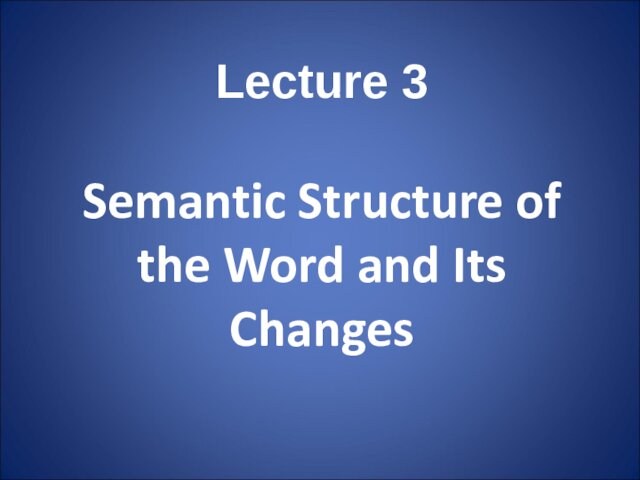
Its Changes
Слайд 2
Plan:
Semantics / semasiology. Different approaches to word-meaning.
Types of
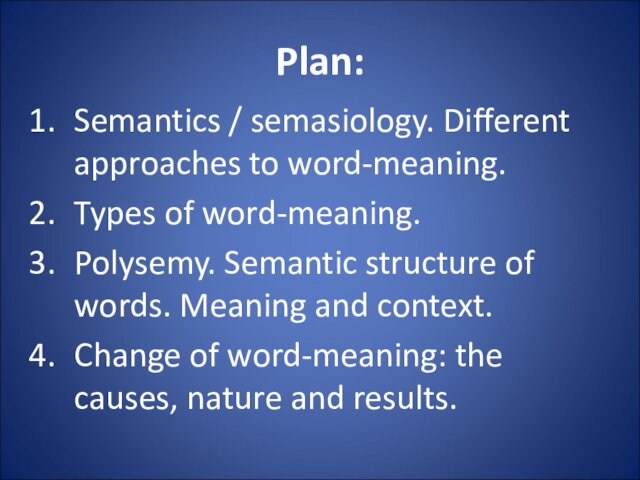
word-meaning.
Polysemy. Semantic structure of words. Meaning and context.
Change of word-meaning: the causes, nature and results.
Слайд 3
List of Terms:
semantics
referent
referential meaning
grammatical meaning
lexical meaning
denotational meaning
connotational meaning
polysemantic
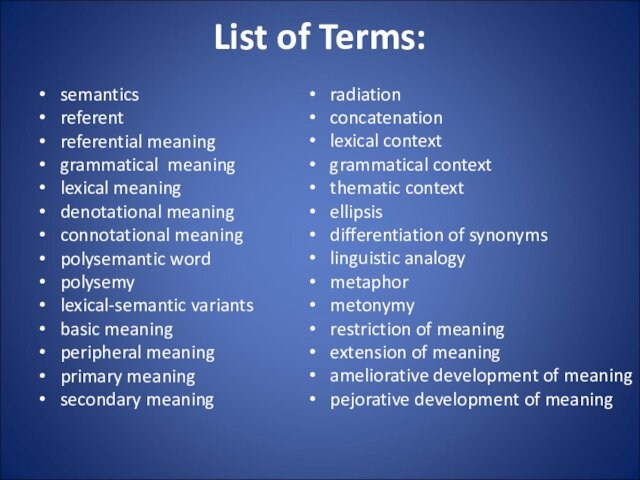
word
polysemy
lexical-semantic variants
basic meaning
peripheral meaning
primary meaning
secondary meaning
radiation
concatenation
lexical context
grammatical context
thematic context
ellipsis
differentiation
of synonyms
linguistic analogy
metaphor
metonymy
restriction of meaning
extension of meaning
ameliorative development of meaning
pejorative
development of meaning
Слайд 4
It is meaning that makes language useful.
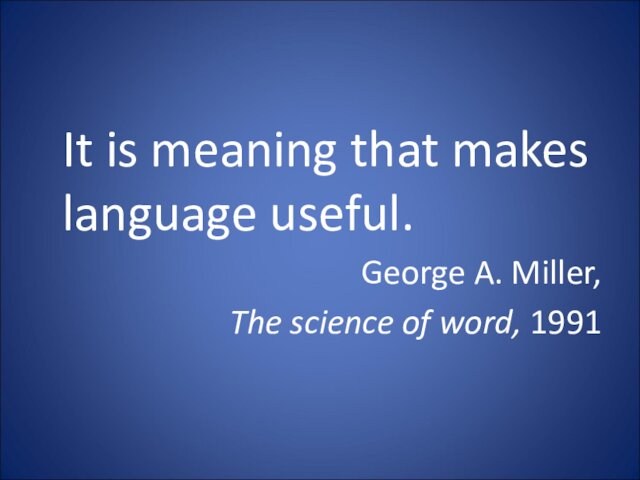
George A. Miller,
The science of word, 1991
Слайд 5
1. Semantics / semasiology. Different approaches to word-meaning
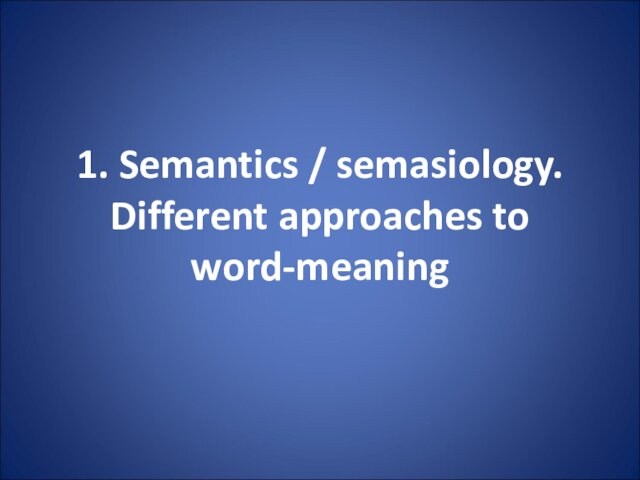
Слайд 6
The function of the word as
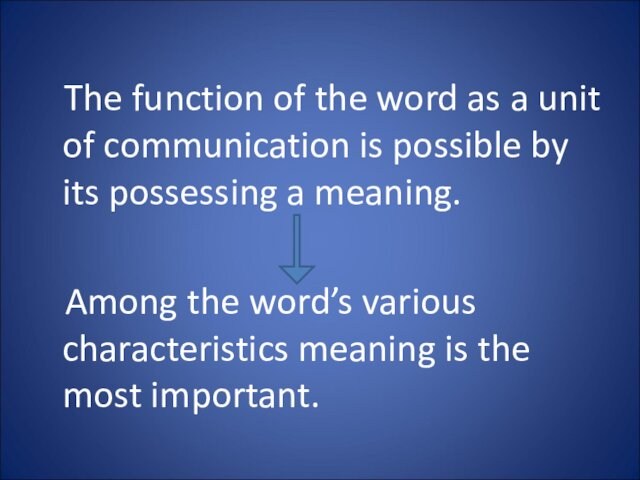
a unit of communication is possible by its possessing
a meaning.
Among the word’s various characteristics meaning
is the most important.
Слайд 7
«The Meaning of Meaning» (1923) by C.K. Ogden
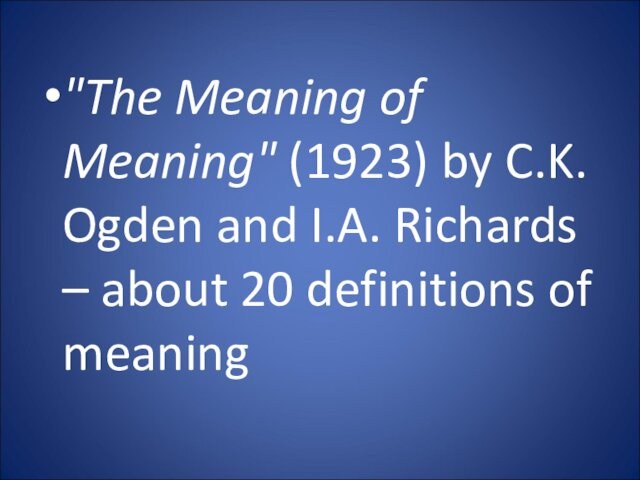
and I.A. Richards – about 20 definitions of meaning
Слайд 8
Meaning of a linguistic unit, or linguistic meaning,
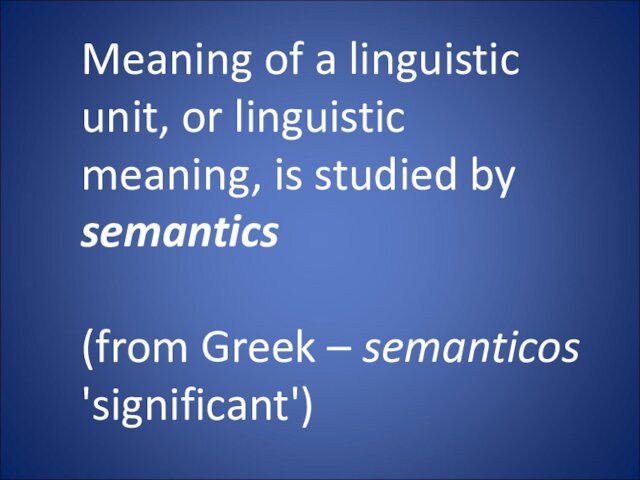
is studied by semantics
(from Greek – semanticos ‘significant’)
Слайд 9
This linguistic study was pointed out
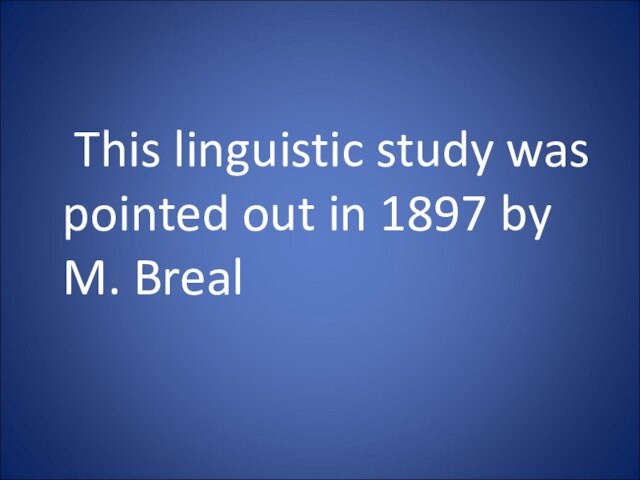
in 1897 by M. Breal
Слайд 10
Semasiology is a synonym for ‘semantics’
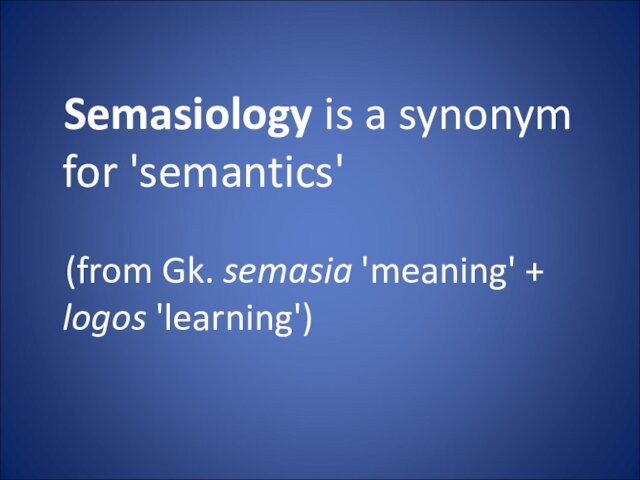
(from Gk. semasia ‘meaning’ + logos ‘learning’)
Слайд 11
Different Approaches to Word Meaning:
ideational (or conceptual)
referential
functional
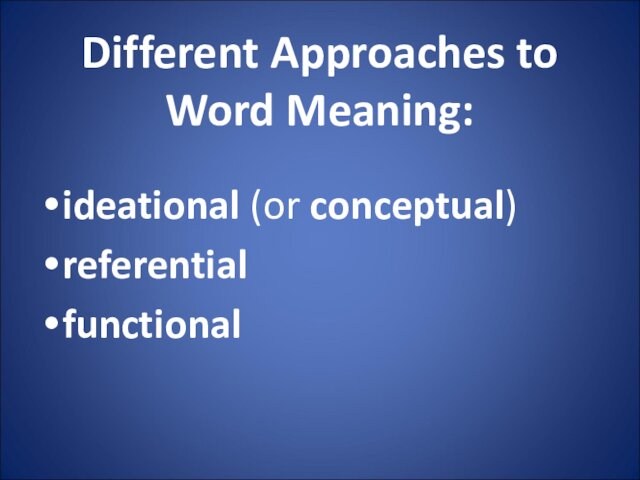
Слайд 12
The ideational theory can be considered
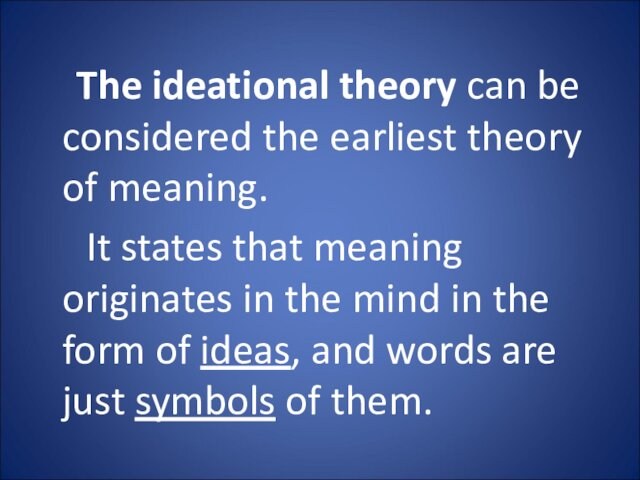
the earliest theory of meaning.
It
states that meaning originates in the mind in the form
of ideas, and words are just symbols of them.
Слайд 13
A difficulty:
not clear why communication and understanding
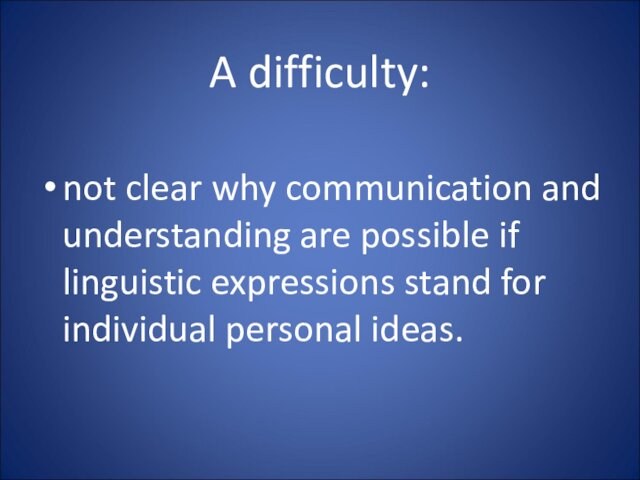
are possible if linguistic expressions stand for individual personal
ideas.
Слайд 14
Meaning:
a concept with specific structure.
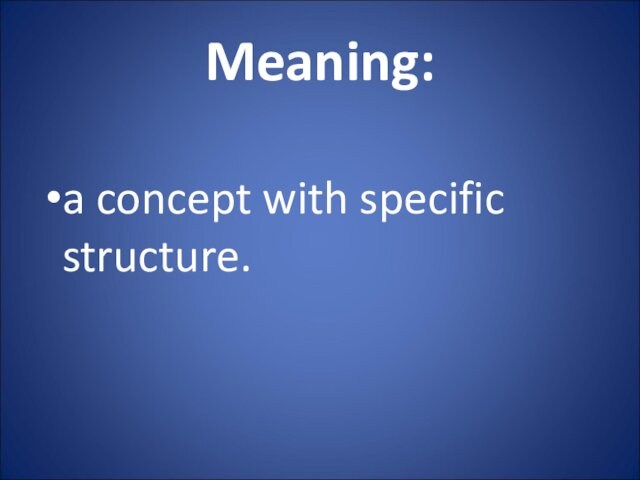
Слайд 15
Do people speaking different languages have different conceptual
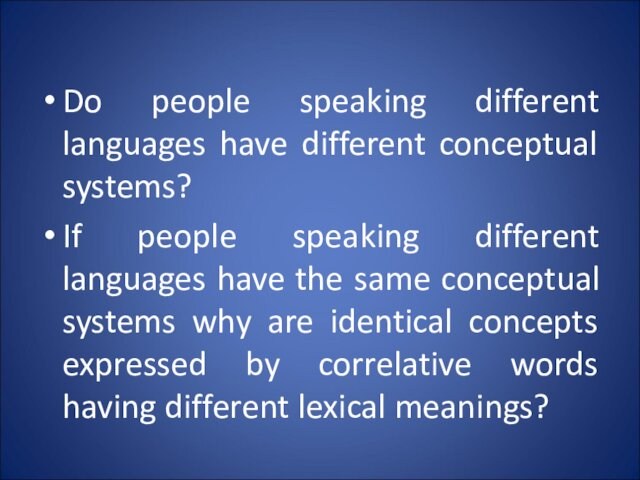
systems?
If people speaking different languages have the same
conceptual systems why are identical concepts expressed by correlative words
having different lexical meanings?
Слайд 16
finger ‘one of 10 movable parts of joints
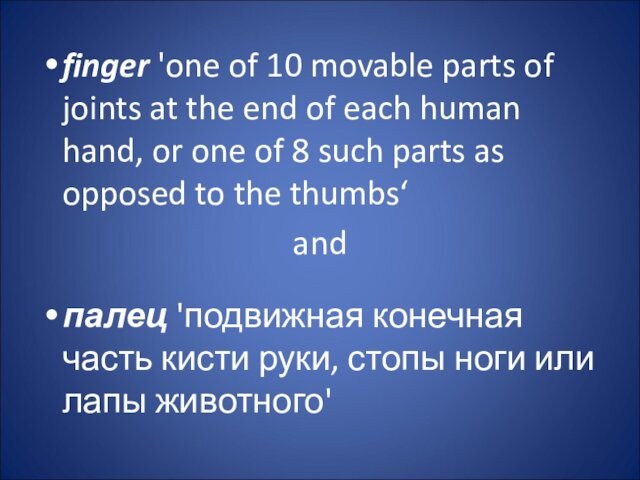
at the end of each human hand, or one
of 8 such parts as opposed to the thumbs‘
and
палец
‘подвижная конечная часть кисти руки, стопы ноги или лапы животного’
Слайд 17
Referential theory is based on
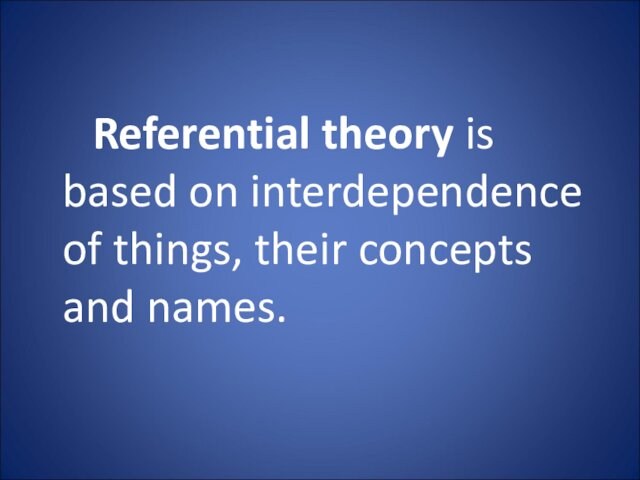
interdependence of things, their concepts and names.
Слайд 18
The complex relationships between referent (object
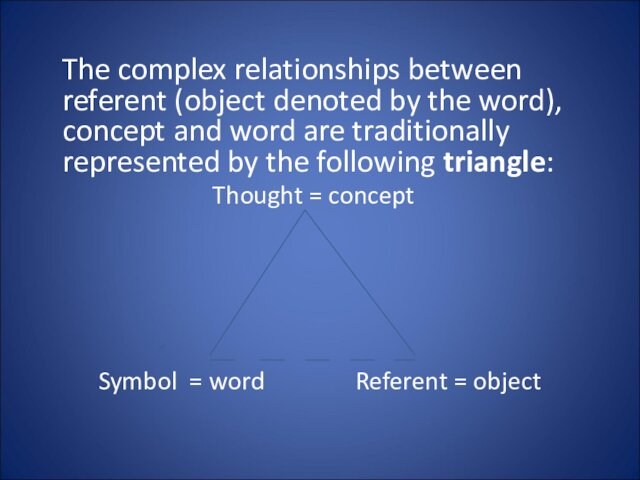
denoted by the word), concept and word are traditionally
represented by the following triangle:
Thought = concept
Symbol = word Referent = object
Слайд 19
an animal, with 4
legs and a tail,
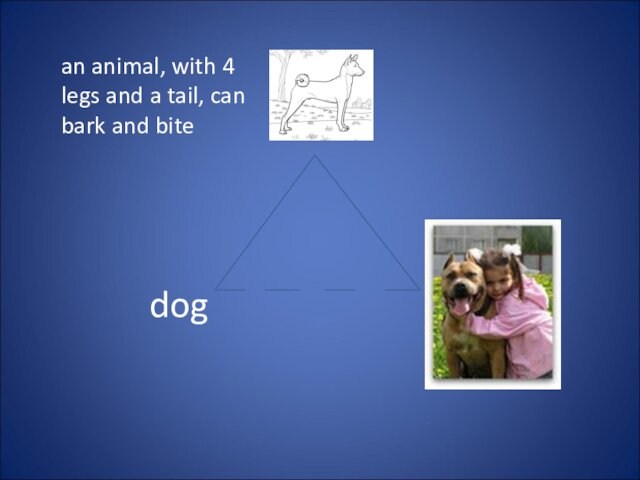
can bark and bite
dog
Слайд 20
Meaning concept
different words having different
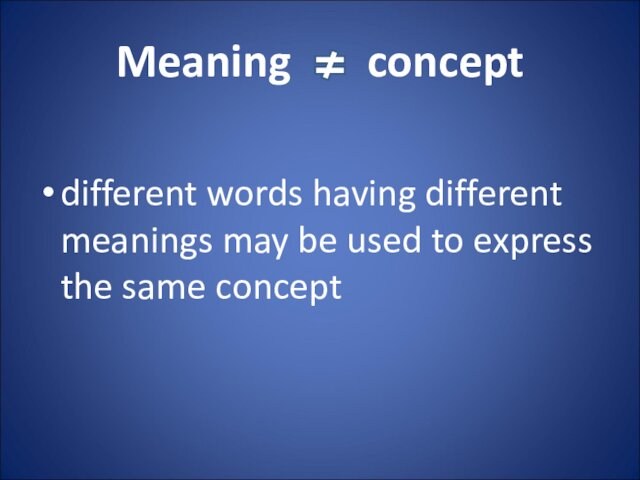
meanings may be used to express the same concept
Слайд 21
Concept of dying
die
pass away
kick the bucket
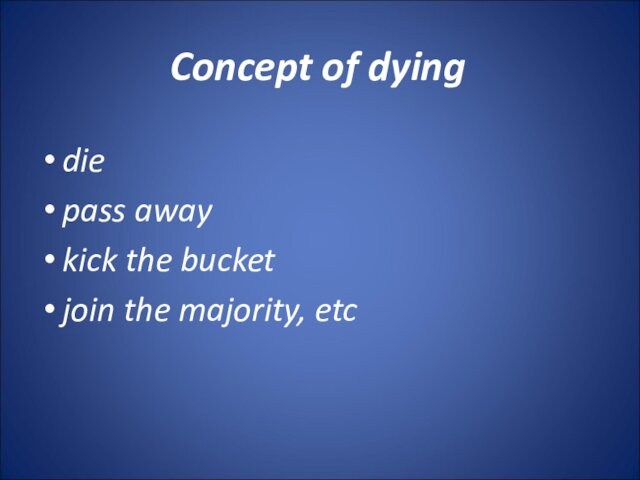
join the majority, etc
Слайд 22
Meaning symbol
In different languages:
a word
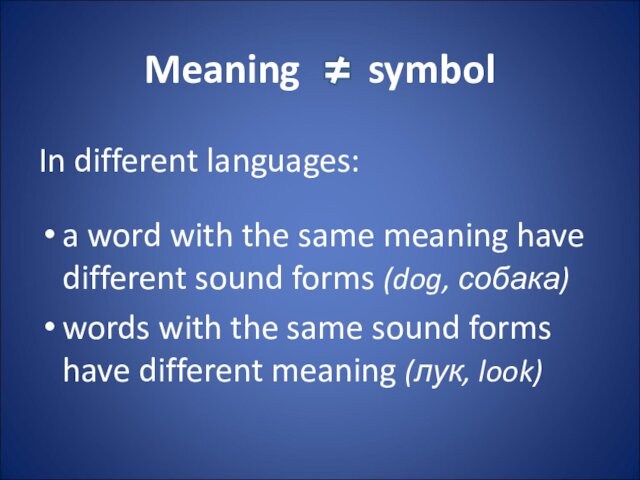
with the same meaning have different sound forms (dog,
собака)
words with the same sound forms have different meaning
(лук, look)
Слайд 23
Meaning referent
to denote one and
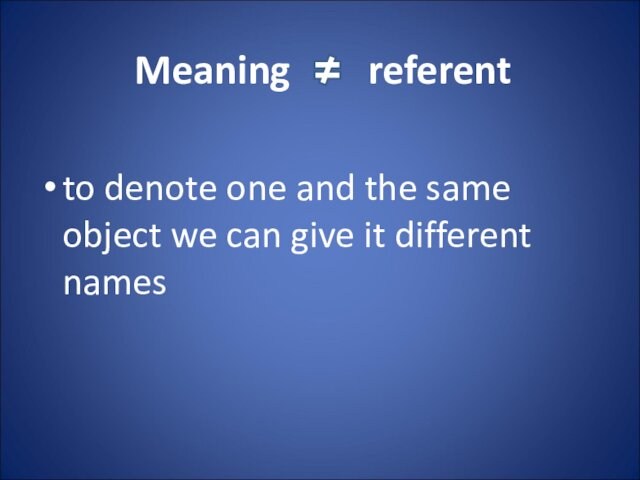
the same object we can give it different names
Слайд 24
A horse
in various contexts:
horse,
animal,
creature,
it, etc.
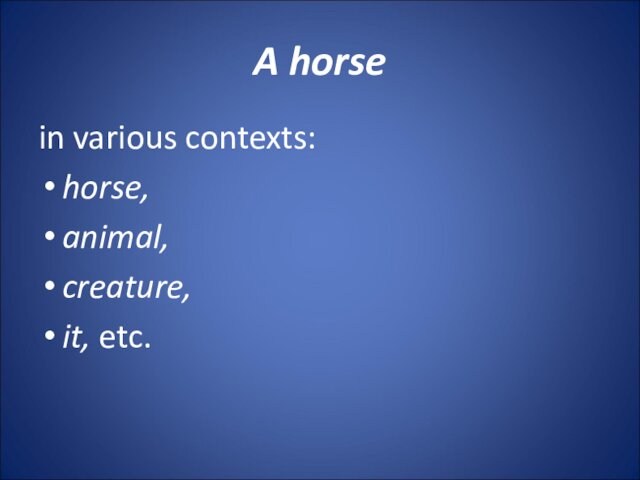
Слайд 25
Word meaning:
the interrelation of all
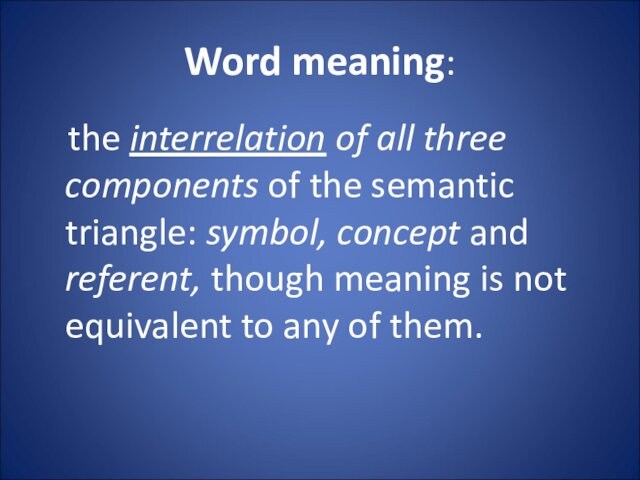
three components of the semantic triangle: symbol, concept and
referent, though meaning is not equivalent to any of them.
Слайд 26
Functionalists study word meaning by analysis
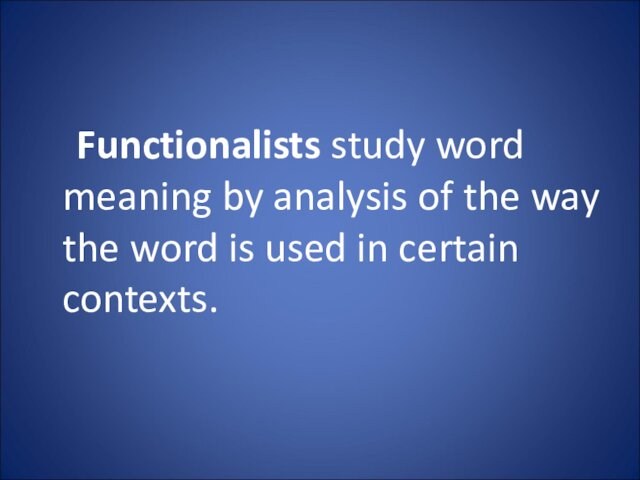
of the way the word is used in certain
contexts.
Слайд 27
The meaning of a word
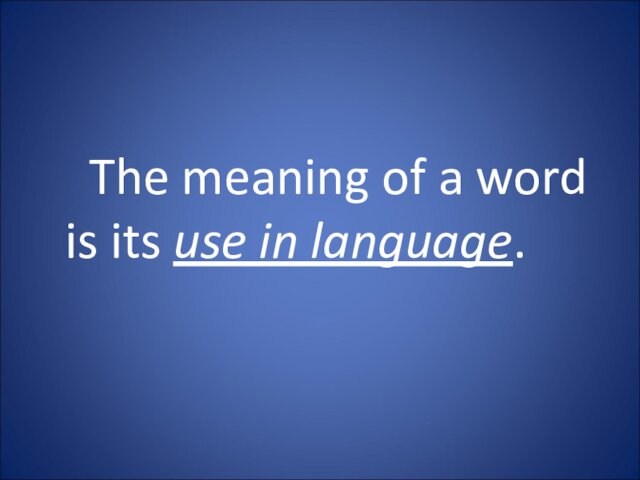
is its use in language.
Слайд 28
cloud and cloudy
have different meanings because in
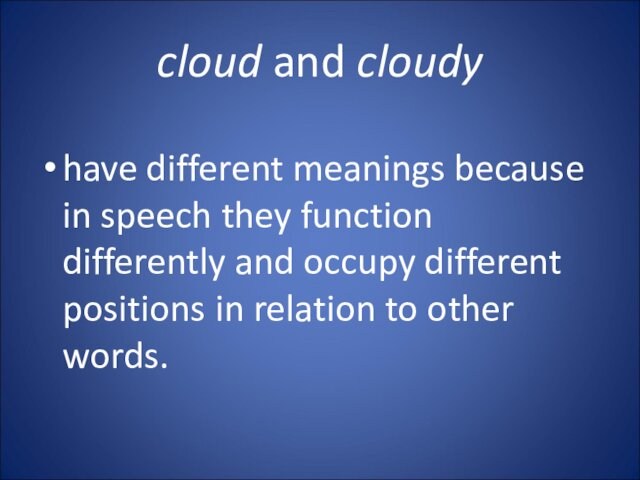
speech they function differently and occupy different positions in
relation to other words.
Слайд 29
Meaning:
a component of the word through
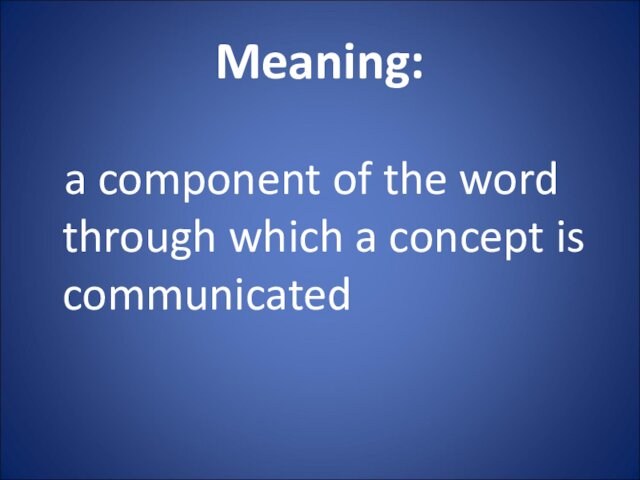
which a concept is communicated
Слайд 31
According to the conception of word meaning as
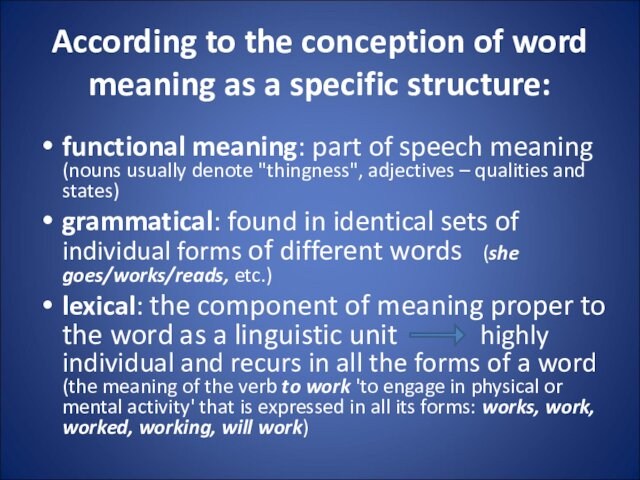
a specific structure:
functional meaning: part of speech meaning (nouns
usually denote «thingness», adjectives – qualities and states)
grammatical: found in
identical sets of individual forms of different words (she goes/works/reads, etc.)
lexical: the component of meaning proper to the word as a linguistic unit highly individual and recurs in all the forms of a word (the meaning of the verb to work ‘to engage in physical or mental activity’ that is expressed in all its forms: works, work, worked, working, will work)
Слайд 32
Lexical Meaning:
denotational
connotational
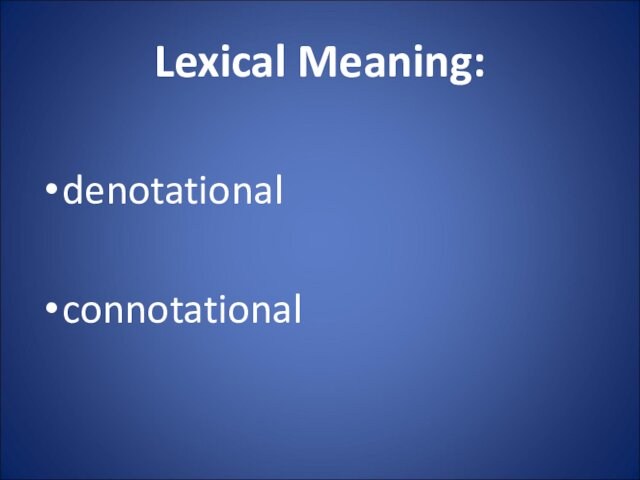
Слайд 33
Denotational lexical meaning provides correct reference of a
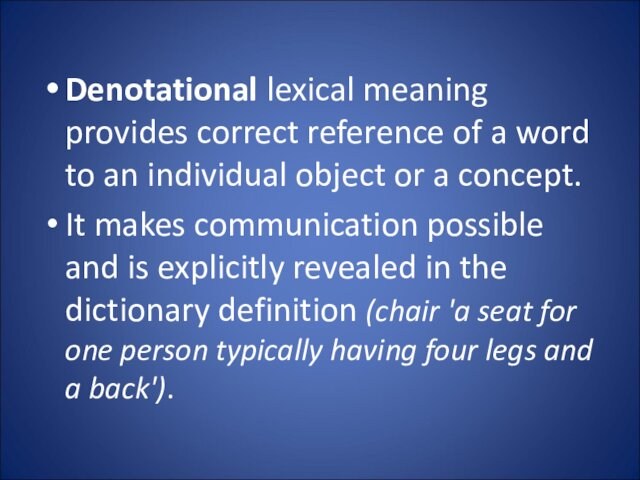
word to an individual object or a concept.
It
makes communication possible and is explicitly revealed in the dictionary
definition (chair ‘a seat for one person typically having four legs and a back’).
Слайд 35
Connotational lexical meaning is an emotional
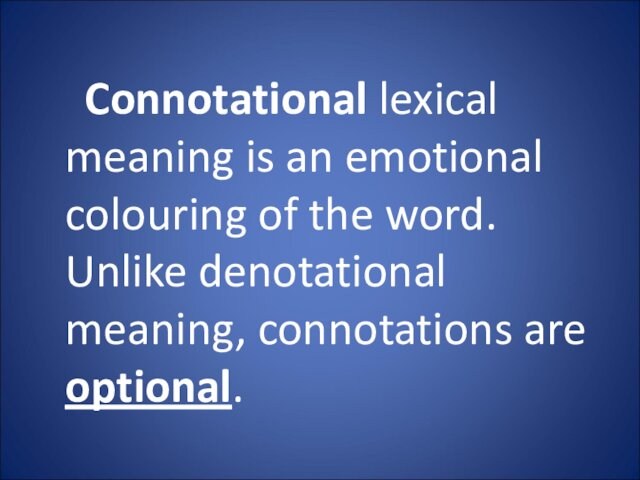
colouring of the word. Unlike denotational meaning, connotations are
optional.
Слайд 36
Connotations:
Emotive charge may be inherent in word meaning
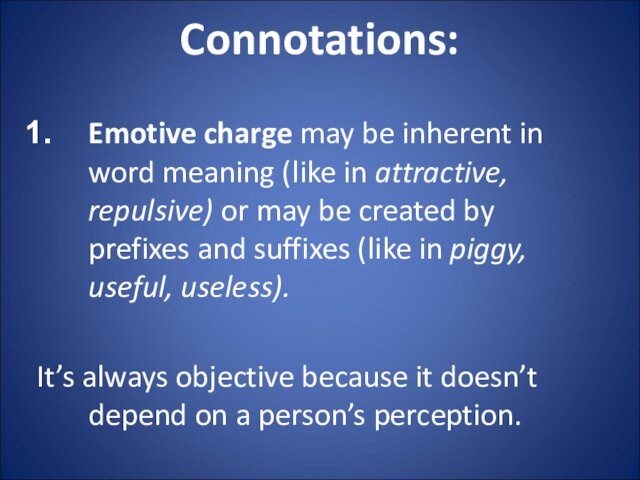
(like in attractive, repulsive) or may be created by
prefixes and suffixes (like in piggy, useful, useless).
It’s
always objective because it doesn’t depend on a person’s perception.
Слайд 37
2. Stylistic reference refers the word to a
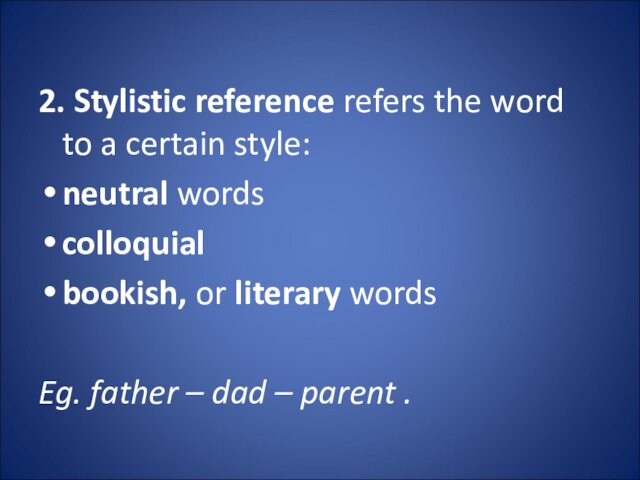
certain style:
neutral words
colloquial
bookish, or literary words
Eg. father –
dad – parent .
Слайд 38
3. Evaluative connotations express approval or disapproval (charming,
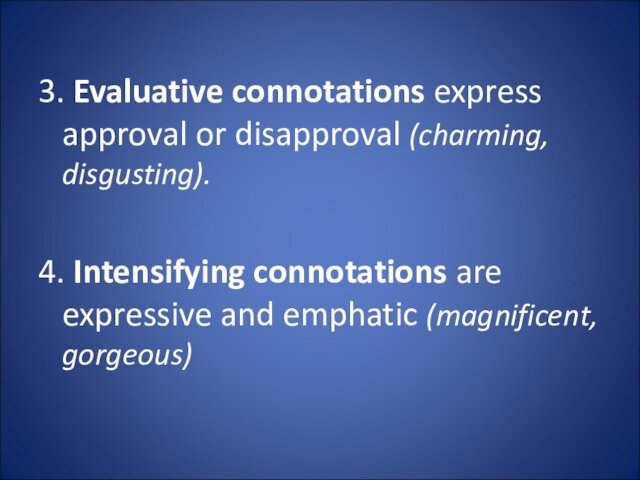
disgusting).
4. Intensifying connotations are expressive and emphatic (magnificent, gorgeous)
Слайд 39
Denotative component
Lonely = alone, without company
To glare =
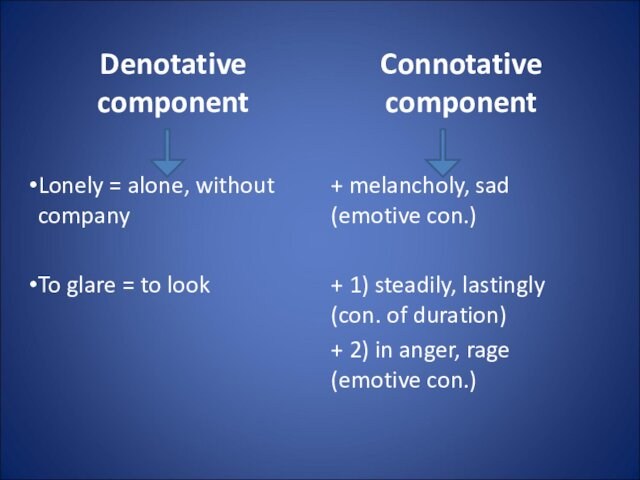
to look
Connotative component
+ melancholy, sad (emotive con.)
+ 1)
steadily, lastingly (con. of duration)
+ 2) in anger, rage (emotive
con.)
Слайд 40
3. Polysemy. Semantic structure of words. Meaning and
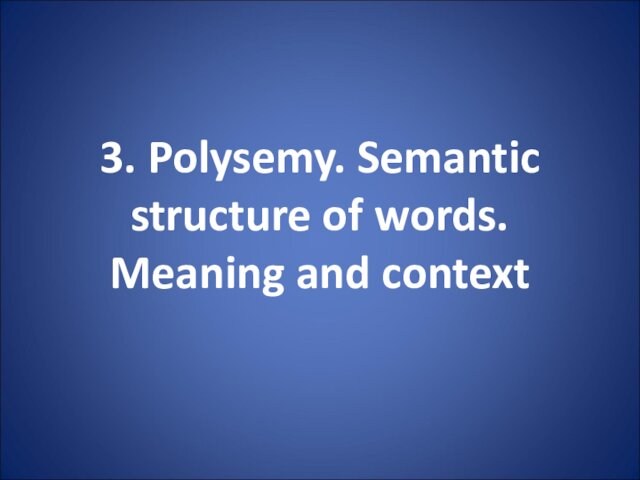
context
Слайд 41
A polysemantic word is a word having more
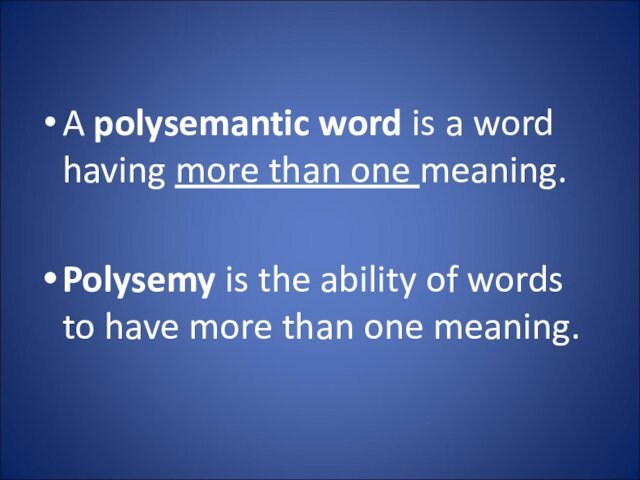
than one meaning.
Polysemy is the ability of words to
have more than one meaning.
Слайд 42
Most English words are
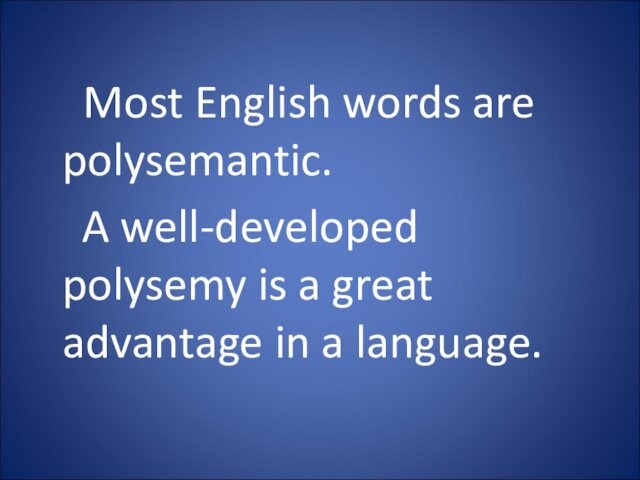
polysemantic.
A well-developed polysemy is a great
advantage in a language.
Слайд 43
Monosemantic Words:
terms (synonym, bronchitis, molecule),
pronouns (this, my,
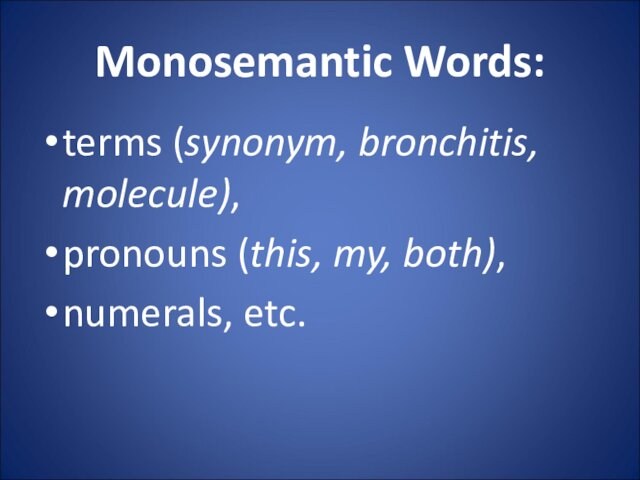
both),
numerals, etc.
Слайд 44
The main causes of polysemy:
a large number of:
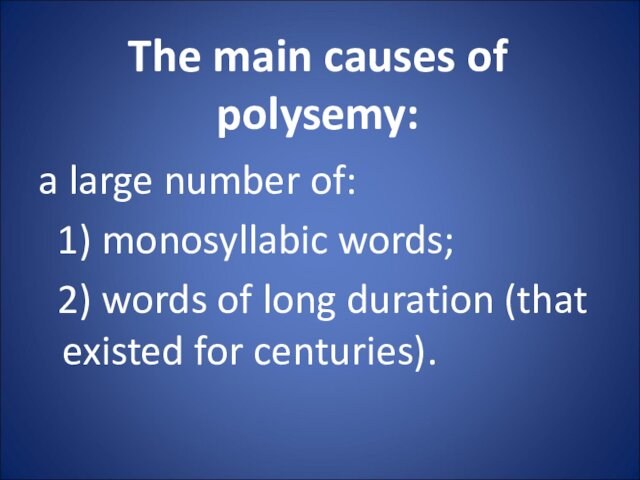
1) monosyllabic words;
2) words of long duration (that
existed for centuries).
Слайд 45
The sources of polysemy:
1) the process of meaning
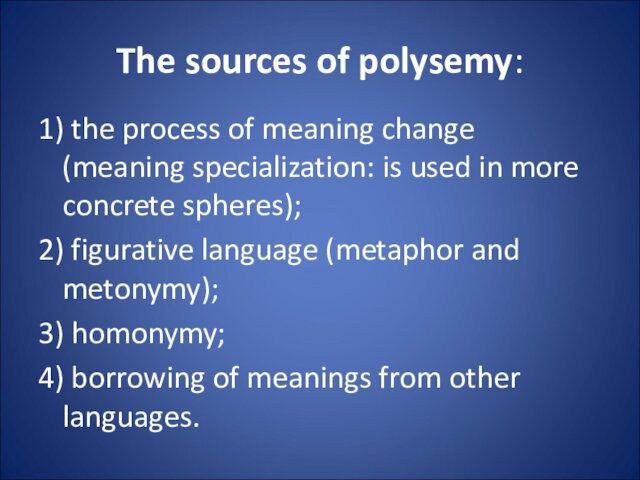
change (meaning specialization: is used in more concrete spheres);
2)
figurative language (metaphor and metonymy);
3) homonymy;
4) borrowing of meanings from
other languages.
Слайд 46
blanket
a woolen covering used on beds,
a covering for
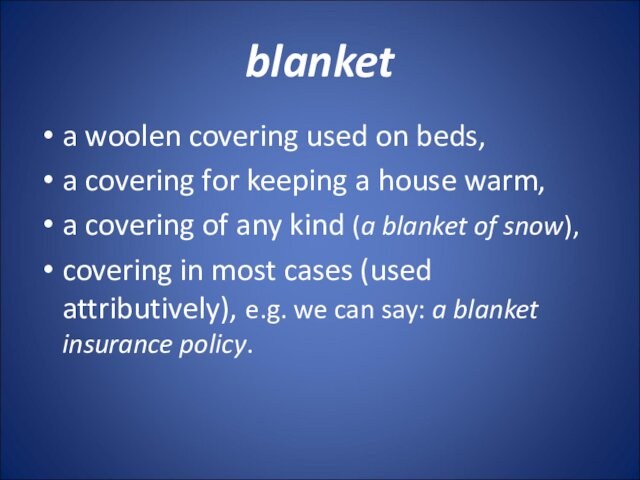
keeping a house warm,
a covering of any kind
(a blanket of snow),
covering in most cases (used attributively),
e.g. we can say: a blanket insurance policy.
Слайд 47
Meanings of a polysemantic word are
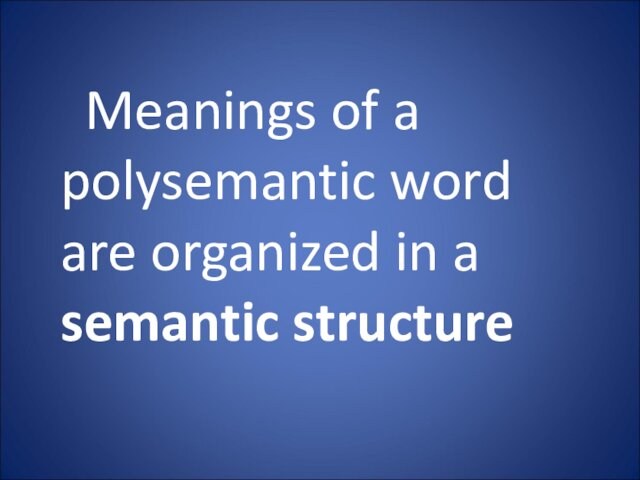
organized in a semantic structure
Слайд 48
Lexical-semantic variant
one of the meanings of a
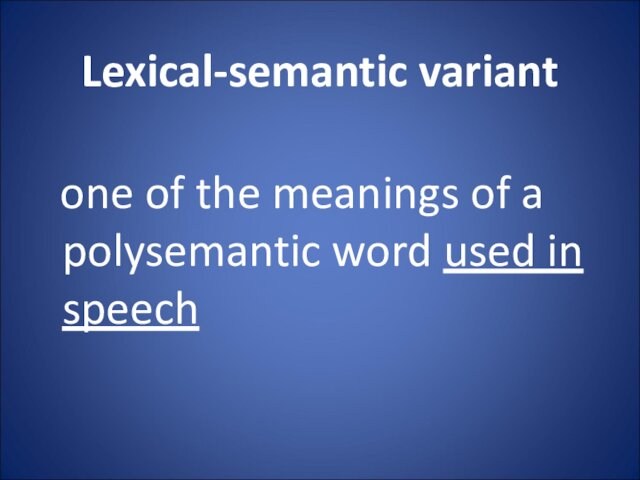
polysemantic word used in speech
Слайд 49
A Word’s Semantic Structure Is Studied:
Diachronically (in the
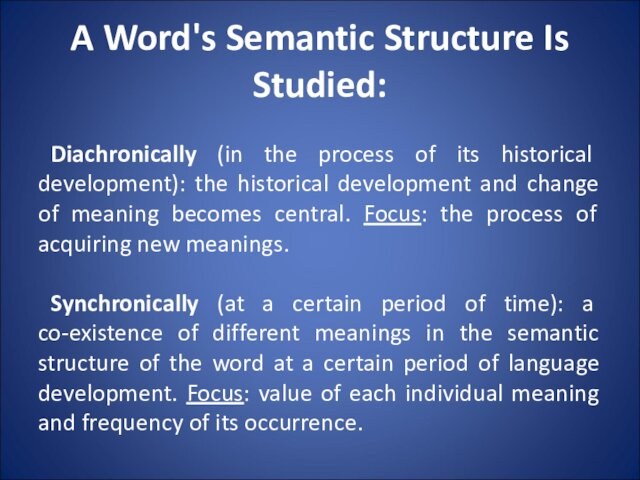
process of its historical development): the historical development and
change of meaning becomes central. Focus: the process of acquiring
new meanings.
Synchronically (at a certain period of time): a co-existence of different meanings in the semantic structure of the word at a certain period of language development. Focus: value of each individual meaning and frequency of its occurrence.
Слайд 50
The meaning first registered in the language is
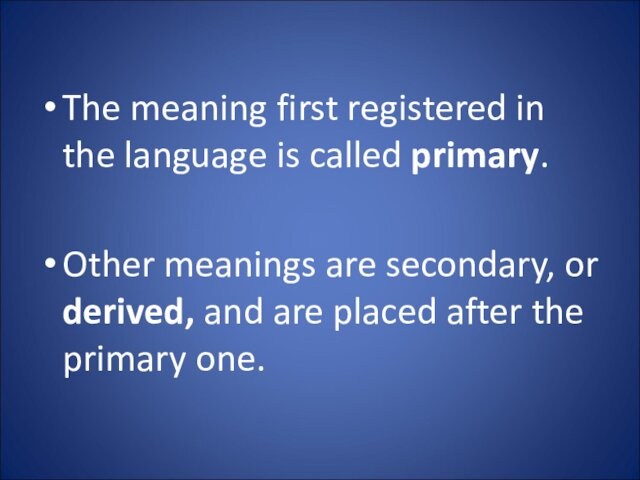
called primary.
Other meanings are secondary, or derived, and
are placed after the primary one.
Слайд 51
table
a piece of furniture
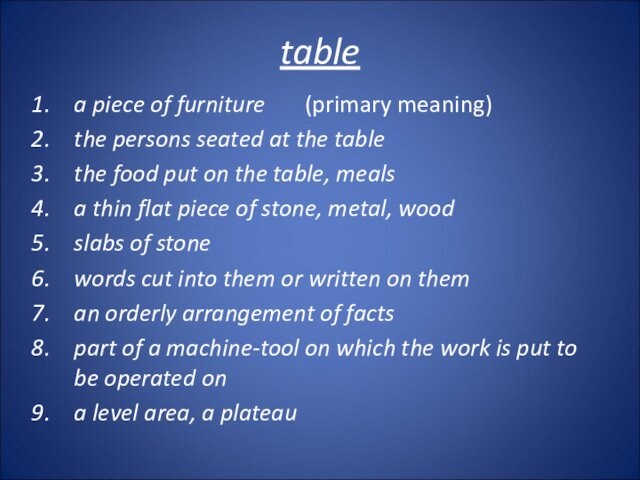
(primary meaning)
the persons seated at the table
the food put
on the table, meals
a thin flat piece of stone, metal,
wood
slabs of stone
words cut into them or written on them
an orderly arrangement of facts
part of a machine-tool on which the work is put to be operated on
a level area, a plateau
Слайд 52
The meaning that first occurs to our mind,
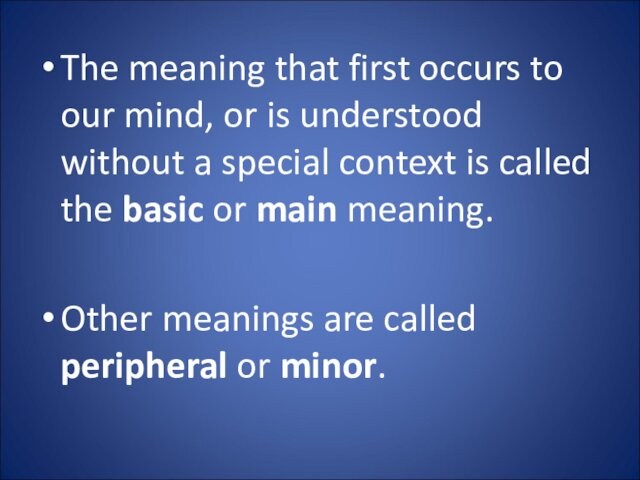
or is understood without a special context is called
the basic or main meaning.
Other meanings are called peripheral
or minor.
Слайд 53
Fire
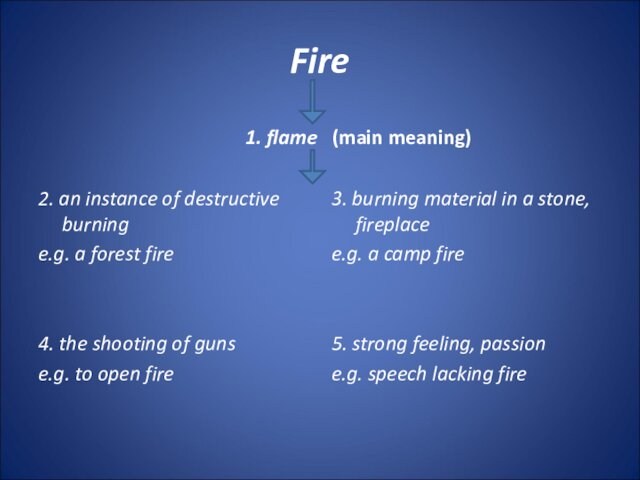
1. flame (main
meaning)
2. an instance of destructive burning
e.g. a forest fire
4. the shooting of guns
e.g. to open fire
3. burning material in a stone, fireplace
e.g. a camp fire
5. strong feeling, passion
e.g. speech lacking fire
Слайд 54
Processes of the Semantic Development of a Word:
radiation
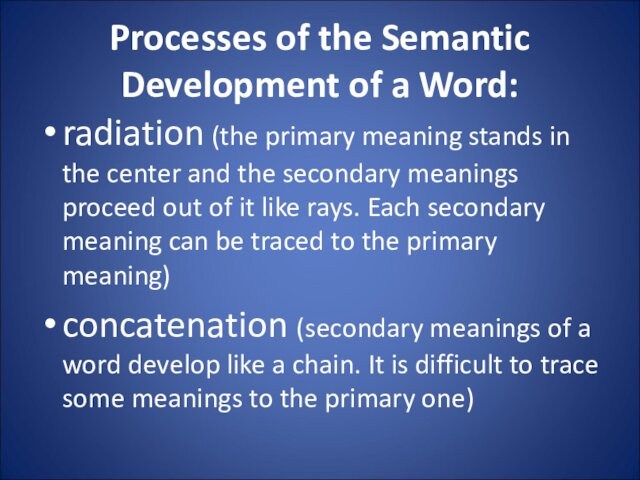
(the primary meaning stands in the center and the
secondary meanings proceed out of it like rays. Each secondary
meaning can be traced to the primary meaning)
concatenation (secondary meanings of a word develop like a chain. It is difficult to trace some meanings to the primary one)
Слайд 55
crust
hard outer part of bread
hard part
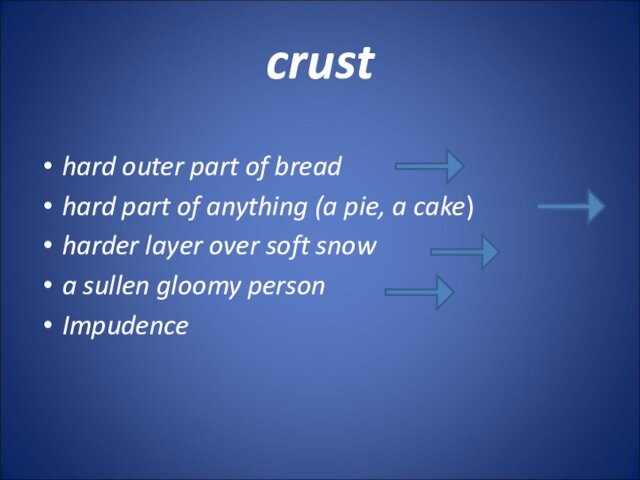
of anything (a pie, a cake)
harder layer over soft
snow
a sullen gloomy person
Impudence
Слайд 56
Polysemy exists not in speech but in
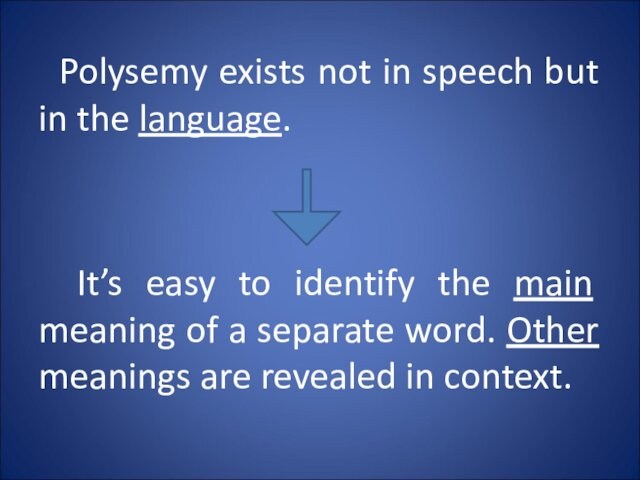
the language.
It’s easy to identify the main meaning
of a separate word. Other meanings are revealed in context.
Слайд 57
Context:
linguistic
1. lexical – a number
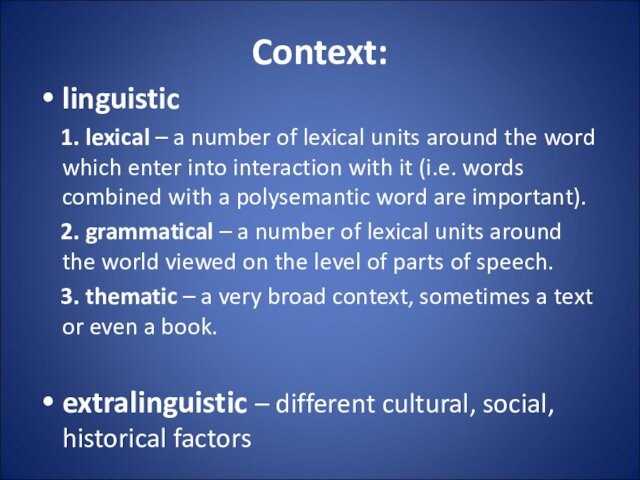
of lexical units around the word which enter into
interaction with it (i.e. words combined with a polysemantic word
are important).
2. grammatical – a number of lexical units around the world viewed on the level of parts of speech.
3. thematic – a very broad context, sometimes a text or even a book.
extralinguistic – different cultural, social, historical factors
Слайд 58
4. Change of word-meaning: the causes, nature and
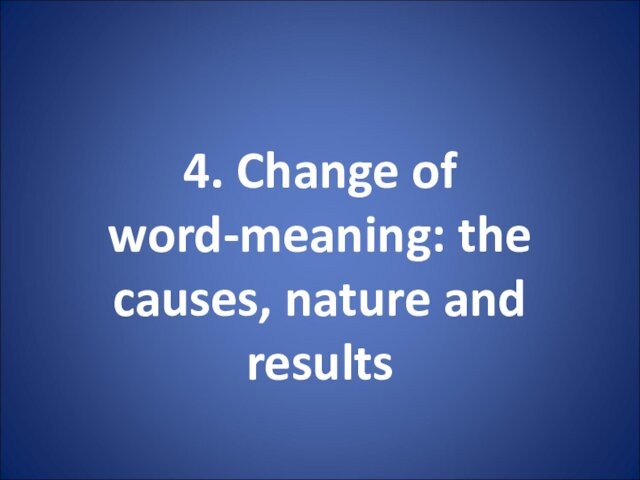
results
Слайд 59
The meaning of a word can change
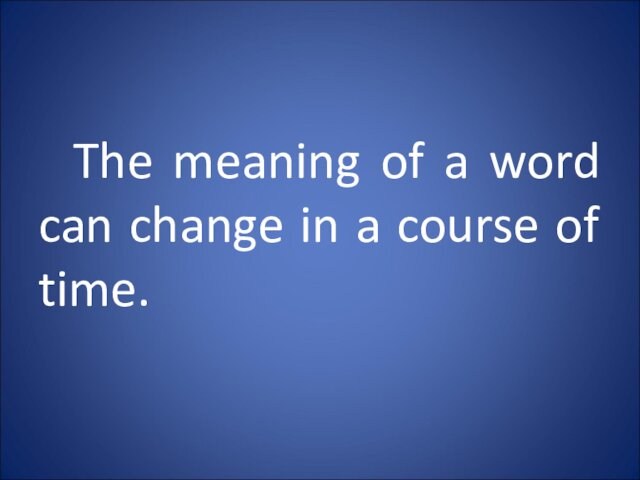
in a course of time.
Слайд 60
Causes of Change of
Word-meaning:
1. Extralinguistic (various changes
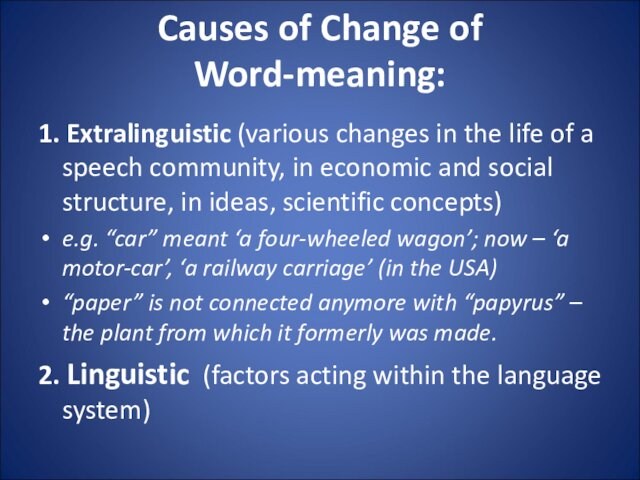
in the life of a speech community, in economic
and social structure, in ideas, scientific concepts)
e.g. “car” meant ‘a
four-wheeled wagon’; now – ‘a motor-car’, ‘a railway carriage’ (in the USA)
“paper” is not connected anymore with “papyrus” – the plant from which it formerly was made.
2. Linguistic (factors acting within the language system)
Слайд 61
Linguistic Causes:
1. ellipsis – in a phrase made
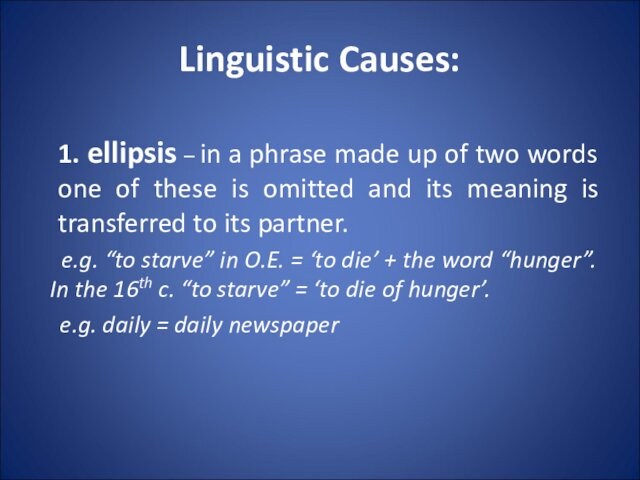
up of two words one of these is omitted
and its meaning is transferred to its partner.
e.g. “to starve” in O.E. = ‘to die’ + the word “hunger”. In the 16th c. “to starve” = ‘to die of hunger’.
e.g. daily = daily newspaper
Слайд 62
Linguistic Causes:
2. differentiation (discrimination) of synonyms –
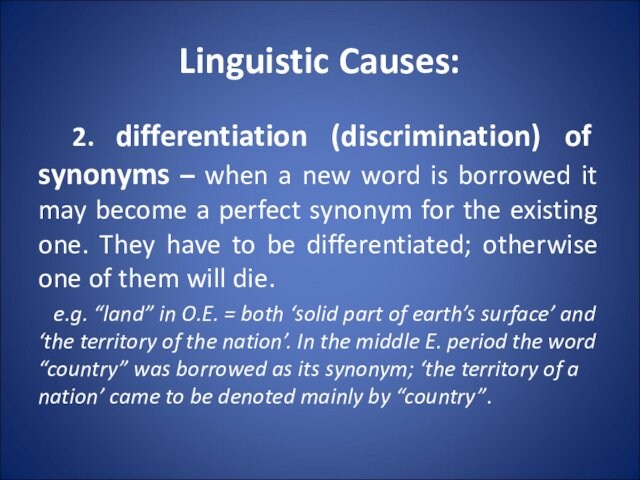
when a new word is borrowed it may become
a perfect synonym for the existing one. They have to
be differentiated; otherwise one of them will die.
e.g. “land” in O.E. = both ‘solid part of earth’s surface’ and ‘the territory of the nation’. In the middle E. period the word “country” was borrowed as its synonym; ‘the territory of a nation’ came to be denoted mainly by “country”.
Слайд 63
Linguistic Causes:
3. linguistic analogy – if one of
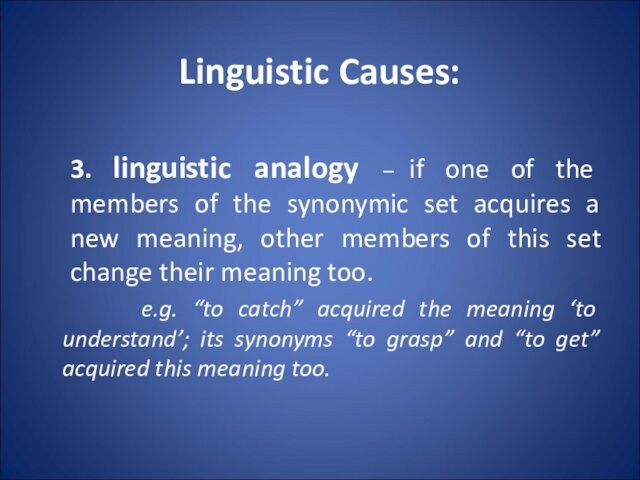
the members of the synonymic set acquires a new
meaning, other members of this set change their meaning too.
e.g. “to catch” acquired the meaning ‘to understand’; its synonyms “to grasp” and “to get” acquired this meaning too.
Слайд 64
The nature of semantic changes is
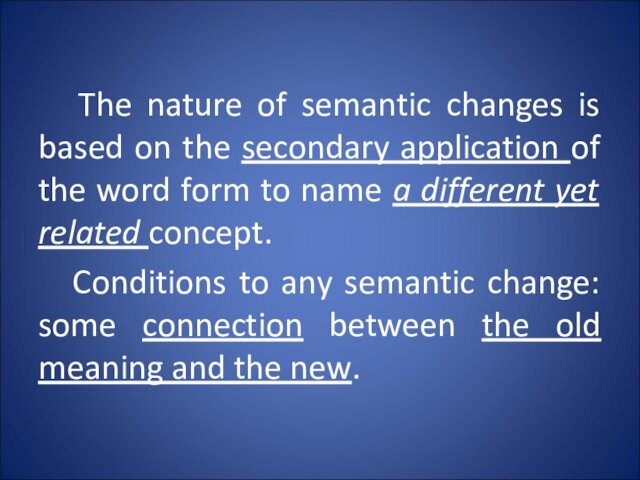
based on the secondary application of the word form
to name a different yet related concept.
Conditions
to any semantic change: some connection between the old meaning and the new.
Слайд 65
Association between Old Meaning and New:
similarity of meanings
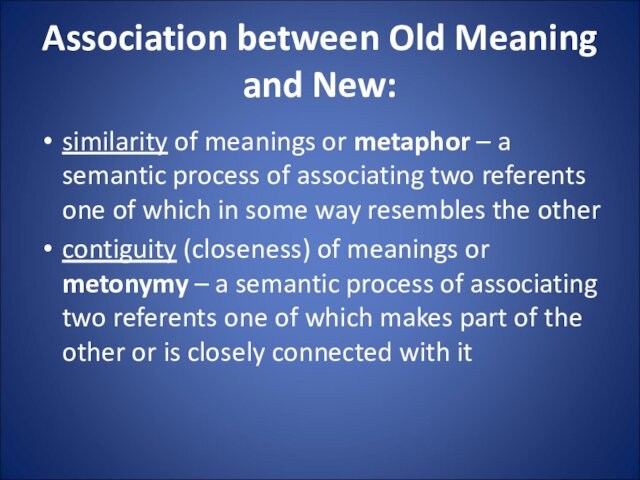
or metaphor – a semantic process of associating two
referents one of which in some way resembles the other
contiguity
(closeness) of meanings or metonymy – a semantic process of associating two referents one of which makes part of the other or is closely connected with it
Слайд 66
Types of Metaphor:
a) similarity of shape, e.g. head
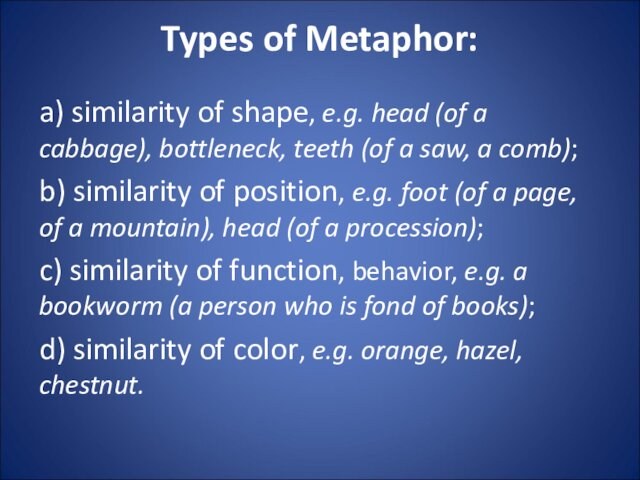
(of a cabbage), bottleneck, teeth (of a saw, a
comb);
b) similarity of position, e.g. foot (of a page, of
a mountain), head (of a procession);
c) similarity of function, behavior, e.g. a bookworm (a person who is fond of books);
d) similarity of color, e.g. orange, hazel, chestnut.
Слайд 67
Types of Metonymy:
‘material — object of it’ (She
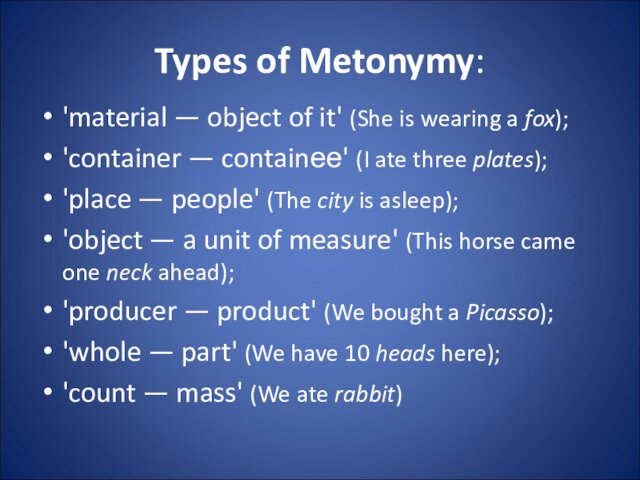
is wearing a fox);
‘container — containее’ (I ate three
plates);
‘place — people’ (The city is asleep);
‘object — a unit
of measure’ (This horse came one neck ahead);
‘producer — product’ (We bought a Picasso);
‘whole — part’ (We have 10 heads here);
‘count — mass’ (We ate rabbit)
Слайд 68
Results of Semantic Change:
changes in the denotational component
changes
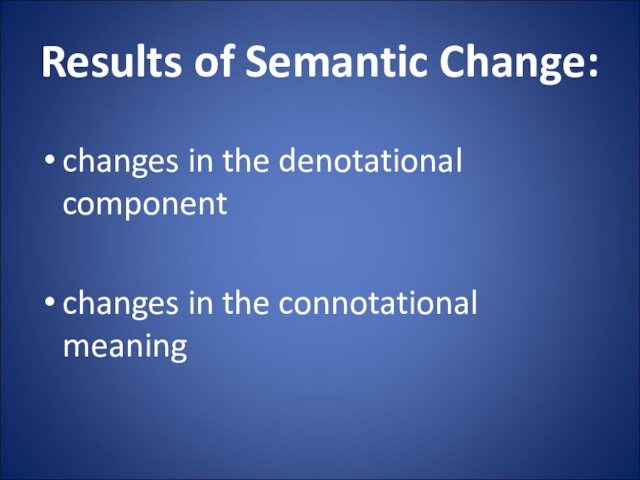
in the connotational meaning
Слайд 69
Changes in the Denotational Component:
restriction – a word
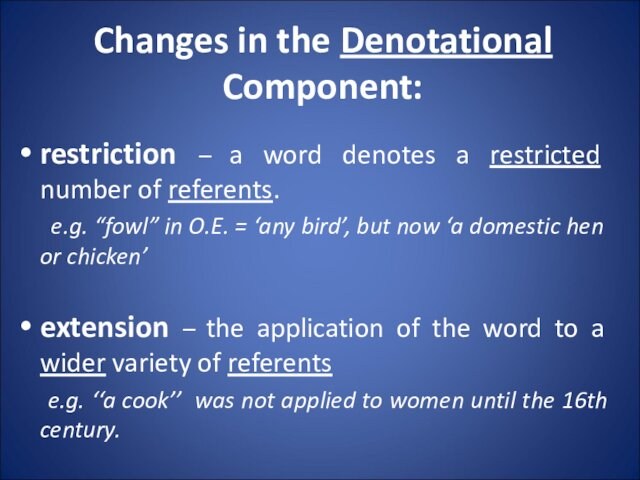
denotes a restricted number of referents.
e.g.
“fowl” in O.E. = ‘any bird’, but now ‘a domestic
hen or chicken’
extension – the application of the word to a wider variety of referents
e.g. ‘‘a cook’’ was not applied to women until the 16th century.
Слайд 70
generalization – the word with the extended meaning
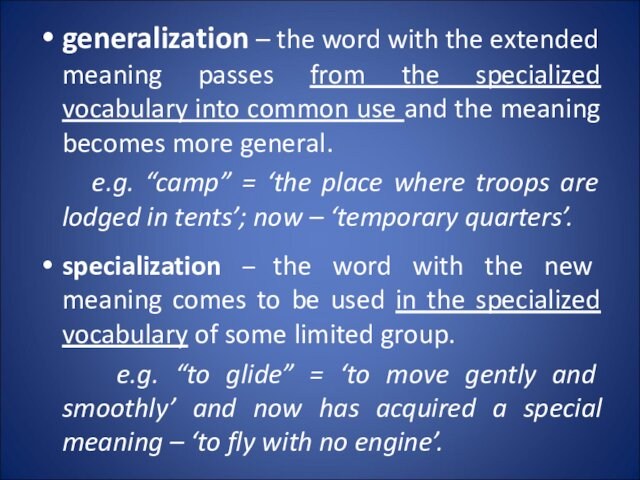
passes from the specialized vocabulary into common use and
the meaning becomes more general.
e.g. “camp” =
‘the place where troops are lodged in tents’; now – ‘temporary quarters’.
specialization – the word with the new meaning comes to be used in the specialized vocabulary of some limited group.
e.g. “to glide” = ‘to move gently and smoothly’ and now has acquired a special meaning – ‘to fly with no engine’.
Слайд 71
Changes in the Connotational Meaning:
pejorative development (degradation) –

the acquisition by the word of some derogatory emotive
charge.
e.g. “accident” ‘a happening causing loss or
injury’ came from more neutral ‘something that happened’;
ameliorative development (elevation) – the improvement of the connotational component of meaning.
e.g. “a minister” denoted a servant, now – ‘a civil servant of higher rank, a person administering a department of state’
Слайд 72
List of Literature:
Антрушина, Г. Б. Лексикология английского языка:
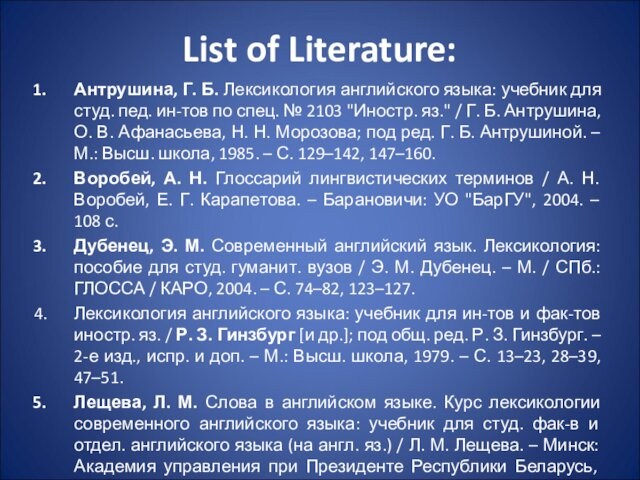
учебник для студ. пед. ин-тов по спец. № 2103
«Иностр. яз.» / Г. Б. Антрушина, О. В. Афанасьева, Н.
Н. Морозова; под ред. Г. Б. Антрушиной. – М.: Высш. школа, 1985. – С. 129–142, 147–160.
Воробей, А. Н. Глоссарий лингвистических терминов / А. Н. Воробей, Е. Г. Карапетова. – Барановичи: УО «БарГУ», 2004. – 108 с.
Дубенец, Э. М. Современный английский язык. Лексикология: пособие для студ. гуманит. вузов / Э. М. Дубенец. – М. / СПб.: ГЛОССА / КАРО, 2004. – С. 74–82, 123–127.
Лексикология английского языка: учебник для ин-тов и фак-тов иностр. яз. / Р. З. Гинзбург [и др.]; под общ. ред. Р. З. Гинзбург. – 2-е изд., испр. и доп. – М.: Высш. школа, 1979. – С. 13–23, 28–39, 47–51.
Лещева, Л. М. Слова в английском языке. Курс лексикологии современного английского языка: учебник для студ. фак-в и отдел. английского языка (на англ. яз.) / Л. М. Лещева. – Минск: Академия управления при Президенте Республики Беларусь, 2001. – С. 36–56.
Lecture 5 Semasiology
- Irina S.Kirichenko
- Associate Professor
TWO PERSPECTIVES ON THE LEXICON
- Semasiological approach: one departs from a word and asks what it means, or what concepts the word refers to.
- word → meaning
- Aim: to identify the concepts that the linguistic form refers to.
- The opposite approach is onomasiological: one departs from a concept referring to an object, a quality, an activity etc. and asks for its linguistic expressions.
- concept → form
- Aim: to find the linguistic forms (lexical units) that can stand for a given concept.
SEMASIOLOGY AND ONOMASIOLOGY
- Semasiology, syn. semiology (from the Greek semasia (sēma “sign”, semantionos “signification”). Semasiology (Gr. sēmasia ‘signification, meaning’ and lógos ‘study’) is a sundiscipline of lexical semantics concerned with the studies of the word meaning in the direction: ‘from the sound form – to its meaning (or meanings)’.
SEMASIOLOGY AND ONOMASIOLOGY
- Onomasiology (from Gr. onoma ‘name’ and logos ‘study of’); “the study of designations”. Onomasiology (Gr. ònomasía ‘name, designation’, logos ‘study’) is a subdiscipline of lexical semantics that studies the word meaning in the direction ‘from the concept – to a sound form (or forms)’. Thesauruses are compiled according to onomasiological principles.
- Onomasiological approach underlines theory of nomination, which aims to show how objects and notions receive their names and what features are chosen to represent them.
MODELS OF MEANING:
- Saussure’s “egg”
- signified (semantic side) / concept
- signifier (formal side) / sound image
- the linguistic sign is binary
- the connection between signified and signifier is arbitrary
- extralinguistic objects denoted by linguistic signs are not included
- linguistic signs are abstracted from their functions and users
2. Semantic Triangle (C.K.Ogden and I.A.Richards in The Meaning of Meaning (1923)
Reference
Symbol Referent
Thought or Reference (Ogden, Richards) / Concept (Pierce) /
Interpretant
A small domesticated carnivorous mammal
kept as a pet and existing in a variety of breeds
Symbol (Ogden, Richards) / Referent (Ogden, Richards) /
Sound-form / Sign (Pierce) Object (Pierce)/Phenomenon
CAT [ kæt]
3. “Organon” (instrumental) model (Plato; Bühler in Linguistic Theory (1934); later Jakobson)
APPROACHES TO THE STUDY OF MEANING
- REFERENTIAL approach seeks to formulate the essence of meaning by establishing the interdependence between words and the things or concepts they denote:
- Meaning is the relation between the object or phenomenon named and the name itself
- The sound-form & the referent are connected indirectly:
- More than one word for the same referent, e.g. cat – mouser, pet, animal, creature, this, mine.
- The same sound-form can refer to different objects, e.g. seal ‘animal’ and seal ‘stamp’; book in English and бук in Ukr.
- Changes in the sound-form do not necessarily affect its meaning: OEn heorte – ModEn heart.
APPROACHES TO THE STUDY OF MEANING
- Strong point: an attempt to link the notion of meaning with the process of naming objects or phenomena of objective reality.
- Week points:
- The reference of words outside their context may be unclear: a particular referent vs. a class of referents
- The referential definition does not consider connotations: That’s very clever.
- One word may denote different objects & phenomena (homonymy and polysemy); or one & the same object may be denoted by different words (synonymy).
- The FUNCTIONAL APPROACH maintains that the meaning of a linguistic unit may be studied only through its relation to other linguistic-units and not through its relation to either concept or referent.
- In the functional approach
- semantic studies are confined to the analysis of the difference or sameness of meaning;
- meaning is understood essentially as the function of the use of linguistic units. As a matter of fact, this line of semantic investigation is the primary concern, implied or expressed, of all structural linguists.
SEMANTIC STRUCTURE OF WORDS
- TYPES OF MEANING:
- Direct meaning (primary meaning) is the meaning which characterises the referent without the help of a context, in isolation.
- Indirect meaning (figurative / secondary / derived meaning) is the meaning formed from the direct meaning according to the models of semantic derivation; it is realised only in definite contexts.
- Main meaning possesses the highest frequency at the present stage of vocabulary development.
- Etymological meaning is the earliest known meaning, e.g. urchin, n. ‘a mischievous or naughty child, esp. a boy’ < ‘a hedgehog’.
- Archaic meaning is the meaning superseded at present by a newer














